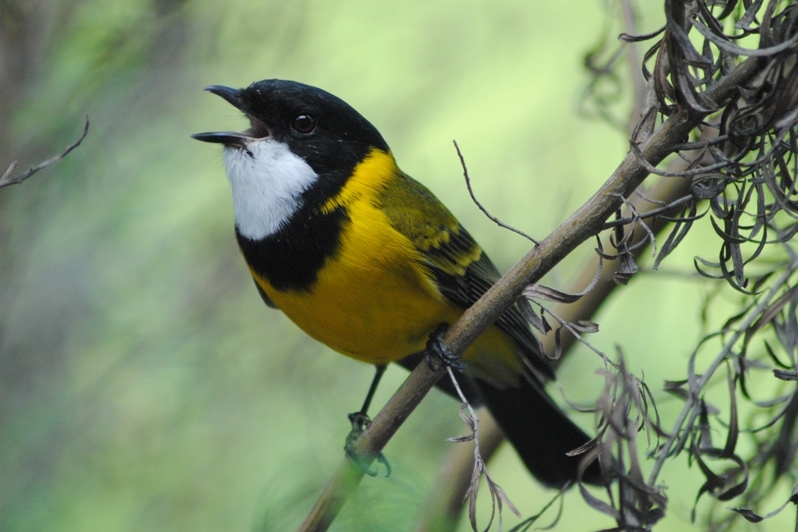A golden whistler (Pachycephala pectoralis) in song … just one of many bird species whose singing behaviour may be influenced by the total eclipse on 14 November (Photo courtesy of Peter Murrell)
At 6:38 am on 14 November, a total eclipse will occur south of Port Douglas in Far North Queensland. Although it will last for only about two minutes, researchers from Queensland University of Technology (QUT) and James Cook University (JCU) will be on hand at TERN’s FNQ Rainforest Supersite to observe a rare phenomenon: a false dawn chorus in bird species that, believing the sun is going down, first become quiet and then start calling again as the sun re-emerges.
To accurately measure the amount of calling and the intensity of the calls, the researchers will deploy acoustic sensors to record both the true dawn chorus as the sun rises and the false dawn chorus as the eclipse umbra (the shadow cast by the moon) passes. One of the researchers involved is Dr Michael Towsey from QUT’s Institute for Future Environments.
‘This is an opportunity that seldom comes along, to observe a fairly rare astronomical event, and its effect on bird species in tropical rainforests’, Michael says. ‘We will have acoustic sensors recording at different locations spanning the path of the umbra, so we’ll be able to see the different effects of the eclipse as it passes.’
QUT PhD student Jason Wimmer said false dawn chorus reactions had been observed in other parts of the world, but this was the first study of its kind to use acoustic sensors to record calling behaviour during an eclipse. ‘We will be recording in positions that span the umbra and penumbra (a partial shadow cast by the moon), which will give us a good indication of how much of a change in light is required to elicit a reaction from the birds. We’ll also know if the intensity of calling varies between the true and false dawn choruses,’ Jason says.
The experiment had sparked developments in the management of acoustic data, Jason said. ‘Acoustic sensors that record over long periods collect a sizable amount of data, and it’s been a challenge to find a method of transferring them to a secure repository with enough storage. We’re developing direct data feeds, and as part of this we’re running an experimental acoustic data repository on the Queensland Cyber Infrastructure Foundation Early Research Node. An acoustics browser has also been developed and is online. The browser presents the audio landscape as a sonogram, a visual representation of an audio recording, and makes use of specialised algorithms to identify acoustic phenomena such as the calls of specific birds, frogs and rain. You can hear one in action on the home page of the website Bush.FM,’ Jason says.
Acoustic sensor technology has been rolled out to the TERN Australian Supersite Network across the major biomes in Australia. The Director of the Samford Ecological Research Facility that makes up part of the SEQ Peri-urban Supersite, Professor Peter Grace, said that the sensors already provided a unique 24-hour-a-day monitoring capability for vocal species such as birds and frogs. ‘This can provide us with insights into the behaviour of many species, and can even act as an early warning system, alerting us to potential changes in the environment’, Peter says. ‘Coupled with detailed, long-term observations of greenhouse gases, soil chemistry, water quality, vegetation and meteorology at the site, we have a wonderful opportunity to see, at a very detailed level, the interactions between the various aspects of our environment.’
During the roll-out to TERN facilities, standards for deploying and analysing acoustic sensor data will be developed for use at other Australian supersites. As Jason says: ‘We face some pretty big challenges to efficiently analyse large volumes of acoustic sensor data. The work we are doing, in collaboration with others, will help us to define standards for analysing acoustic sensor data, and allow us to share our data and our findings with the wider scientific community.’
A recent workshop sponsored by the Australian Centre for Ecological Analysis and Synthesis brought together leading acoustic-sensing researchers from Australia, New Zealand and the United States to develop strategies for large-scale deployments of acoustic sensors, and for the analysis of acoustic-sensor data. The outcomes of this workshop will also inform the TERN acoustic-sensing program.
Peter says: ‘By using acoustic sensors at the national scale we have the potential to contribute to policy and decision making in a much more accurate and informed way, because we can provide timely biodiversity distribution data at geographical and time scales that haven’t been possible till now.’
The results of the eclipse study will be available in December 2012 from the Bush.FM website. For more information about it email Jason Wimmer.
Published in the TERN e-Newsletter October 2012.







